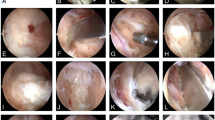Abstract
Degenerative disc disease (DDD) causes gradual intervertebral space collapse, concurrent discogenic or facet-induced pain, and possible compression radiculopathy. A new minimal invasion procedure of percutaneous posterior-lateral lumbar interbody fusion (PPLIF) using a B-Twin stand-alone expandable spinal spacer (ESS) was designed to treat this disease and evaluated by follow-up more than 1 year. 12 cases with chronic low back pain and compressive radiculopathy due to DDD refractory were selected to conservative treatment. Under fluoroscopy in the posterior-lateral position, a K-wire was advanced into the intervertebral space and a dilator and working cannula were introduced into the disc space step by step. Discectomy and endplate scratching were performed through the cannula using pituitary forceps and endplate curettage. An ESS was inserted into the intervertebral space by a B-Twin expandable spinal delivery system after some bone graft chips implanted into the disc space. The ongoing study includes intraoperative difficulties, complications, radiologic evidence of fusion and clinical outcome as scored by pre- and postoperative questionnaires pertaining to pain intensity and degree of disability. The 12 procedures of lumbar interbody fusion using stand-alone expandable spinal system through percutaneous approach were successful. Radiologic study demonstrated fusion in a total of 11 cases and only 1 exception after more than 1 year visiting. The values of Visual Analog Scale (VAS) on movement and Oswestry Disability Index (ODI) dropped by more than 80 and 67.4%, respectively. Disk space heights averaging 9.0 mm before procedure were increased to 11.5 mm 1 month (a significant difference compared with preprocedure, P < 0.01) after surgery and stabilized at 10.8 mm upon final follow-up (a significant difference compared with preprocedure, P < 0.01). The results demonstrated that the percutaneous approach for posterior-lateral lumbar interbody fusion using expandable spinal system is a valuable micro-invasion method for the DDD patients and can achieve the same outcome as with other methods.







Similar content being viewed by others
References
Agazzi S, Reverdin A, May D (1999) Posterior lumbar interbody fusion with cages: an independent review of 71 cases. J Neurosurg 91:186–192
Brantigan JW, Steffee AD, Lewis ML et al (2000) Lumbar interbody fusion using the Brantigan I/F cage for PLIF and the variable pedicle screw placement system. Spine 25:1437–1446
Elias WJ, Simmons NE, Kaptain GJ (2000) Complications of PLIF when using a titanium threaded cage device. J Neurosurg 93:45–52
Folman Y, Lee SH, Silvera JR et al (2003) Posterior lumbar interbody fusion for degenerative disc disease using a minimally invasive B-Twin expandable spinal spacer: a muticenter study [J]. J Spinal Disord Tech 16(5):455–460
Fenton DS, Czervionke LF (2003) Image-guided Spine Intervention. Saunders: an imprint of Elserier. pp 227–255. ISBN 0-7216-0021-2
Fairbank J, Couper J et al (1980) Oswestry low back pain disability questionnaire. Physiotherapy 66:271–273
Lee CK, Vessa P, Lee JK (1995) Chronic disabling low back pain syndrome caused by internal disc derangements. The result of disc excision and posterior lumbar interbody fusion. Spine 20:356–361
Hacker RJ (1997) Comparison of interbody fusion approaches of disabling low back pain. Spine 22:660–666
McAfee PC, Lee GA, Fedder IL et al (2002) Anterior BAK instrumentation and fusion: complete versus partial discectomy. Clin Orthop 394:55–63
Albumi K, Panjabi MM, Kramer K et al (1990) Biomechanical evaluation of lumbar spine stability after graded facetectomies. Spine 15:1142–1147
Krismer M, Haid C, Rabl W (1996) The contribution of annulus fibers to torque resistance. Spine 21:2551–2557
Wimmer C, Kristner M, Cluch H et al (1999) Autogenoic versus allo-genic bone grafts in anterior lumbar interbody fusion. J Clin Orthop Relat Res 360:120–126
Kuslich SD, Ulstrom CL, Griffit SH et al (1998) The Bagby and kuslich method of lumbar interbody fusion history techniques and 2-year follow-up result of a United States prospective multicenter trial. Spine 23:1267–1278
Author information
Authors and Affiliations
Corresponding author
Rights and permissions
About this article
Cite this article
Xiao, L., Xiong, D., Zhang, Q. et al. Percutaneous posterior-lateral lumbar interbody fusion for degenerative disc disease using a B-Twin expandable spinal spacer. Eur Spine J 19, 325–330 (2010). https://doi.org/10.1007/s00586-009-1167-6
Received:
Revised:
Accepted:
Published:
Issue Date:
DOI: https://doi.org/10.1007/s00586-009-1167-6




